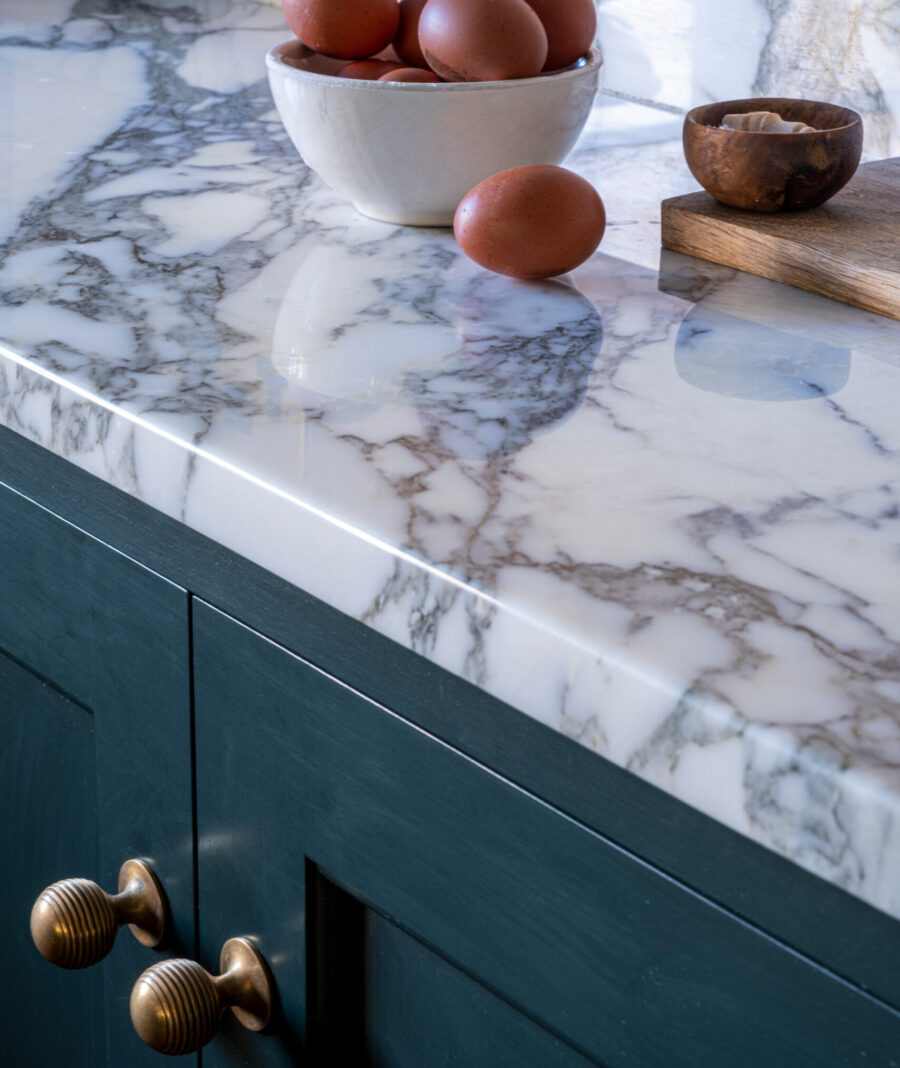Journal
Is marble a good stone to choose for a kitchen worktop?
The Pros and Cons of Marble Worktops
March. 2023
One of the most popular and enduring natural stones that clients are immediately drawn to when choosing their worktops is marble. But what are the pros and cons of using marble worktops in a kitchen? Is marble a good stone to choose for a kitchen worktop?

MARBLE CAN BE TRACED BACK 200 MILLION YEARS
Marble gets its name from the Ancient Greek μάρμαρον (mármaron) which translates as “crystalline rock, shining stone”. Marble is formed from limestone by heat and pressure in the earth’s crust. The conditions it is put under cause the limestone to change in its very makeup, as well as texture and appearance, in a process known as crystallisation.
Clay, sand, or mineral impurities can sometimes create distinctive veins and swirls within the marble, such as colour distortions of red, green, or yellow. These discolourations and distinct veining are what sets is apart. No two pieces are ever the same, and when cut it creates incredibly beautiful unique slabs, adding that final flourish of design to a bespoke kitchen design, creating show stopping results.
Landmarks such as the Taj Mahal, Washington Monument and the Parthenon in Athens are all made of marble.
As marble is a natural stone, many clients believe it can withstand anything. As such some may consider it the obvious choice for a worktop in a bespoke kitchen design, but there are some things to consider.

SPILLS, STAINS AND SCRATCHES
Marble is a relatively soft stone which means it can and will absorb drips, spills and any pigments from food if left sitting on the surface for too long. Lemons, vinegar and tomatoes are acidic, which will create an etched effect to the surface. Oil will be absorbed. Red wine will stain it.
All of these, and many more ingredients will leave their mark if left on the surface for too long, regardless how many cleaning products you throw at it (although harsh chemicals should never be used).
All Guild Anderson marble worksurfaces are protected with Lithofin Stain Stop which slows down the ingress of any stains seeping in to the marble pores. The best way to deal with spillages is to clean them immediately with Lithofin Easy Clean or warm mild soapy water. The longer that a spill remains on the worktop the more difficult it is to remove.
For more stubborn stains such as tea, coffee, paint, wine and other organic stains a poultice can be applied. A poultice is a thick cleaning paste made up of a white absorbent material that is mixed with a liquid chemical or detergent. The liquid cleaner draws the stain out and into the absorbent material. You may have to repeatedly apply the poultice to completely remove certain stains.
The ideal cleaning material for grease and oil stains is corn starch. Sprinkling the corn starch over the grease stained area and leaving for 20 minutes lets the starch absorb the oil. Then use a damp cloth to remove the corn starch and polish with a soft cloth.
The veins that make marble so instantly recognisable are actually impurities within the rock

DURABLE AND EASY TO MAINTAIN
It is also possible to polish your marble worktop using commercially available polish or chalk powder, marble polishing materials are designed for certain colours so it is essential to check that they are the correct product for your marble before using them. Polishing is then followed by buffing, it is best to use a diamond polishing pad or a soft cloth and buff the marble worktop by making circular motions on the surface.
Marble can also scratch and nick easily, and overtime no matter how careful you are, it will inevitably mark and age through stains and scratches, but will develop a patina, unique to you and your work surface.
Sealing the marble annually will reduce the length of time it takes for liquids to seep into the stone, protecting it to a certain degree. Although one product is called Stain Stop, it does not stop stains, but limites them. Like any piece of antique furniture, the bumps and grazes marble acquires along its lifetime will add to the quality and charm of the piece.
Marble is resistant to heat, due to the way that it is formed from volcanic and igneous activity. However you should always be careful to not put hot pans down directly on to its surface.
Marble is most commonly found in Italy, China, India, and Spain. These four countries quarry about half of the world’s marble.

NO TWO SLABS OF MARBLE WILL EVER HAVE THE EXACT SAME PATTERN
No pros and cons of marble worktops article is complete without discussing price. When it comes to the price of marble, it varies enormously. Veining in marble can create natural weaknesses and so some marbles are not suitable to be used in large a slab format.
Some common types of marble such as Carrara marble can be relatively inexpensive even compared to a quartz worktop. Rarer marbles such as Calacatta Viola are more expensive as they are less readily available, they often have more distinct veining.
The design team at Guild Anderson encourage clients to visit the big suppliers to see the large slabs of marble as it gives a far better idea how the worktop will look in situ.
In the video link below Italian artist and filmmaker Yuri Ancarani captures the otherworldly landscape of Carrara’s marble quarries in the Apuan Alps, Northwest Italy, as Il Capo (The Chief) guides his men through the extraction process. It hi-lights the awesome process and extraction of this ancient stone.
Marble has a timeless appeal, one that never goes out of style. As with any natural material, if it is understood and cared for in the correct way it can and will last a lifetime, and is certainly a beautiful product to use in your kitchen design.
These are our preferred marble suppliers;
Bath Granite & Marble has established itself as a leading force in the hard surfaces market and have been fabricating and installing beautiful products since 2001. They specialise in Granite, Marble, Engineered Quartz and Sintered Stone products nationwide.
Landford Stone is a family run company whose directors have been a part of the industry over 45 years. There are currently three generations of the family working for Landford Stone, and the 45 employees whose skills and abilities are industry renowned, have also been with the company for many years.
Silex Specialist Stone Solutions
Silex are the go-to company if your marble surfaces need a refresh, and they specialise in cleaning, grinding, polishing and re-sealing natural stone.



